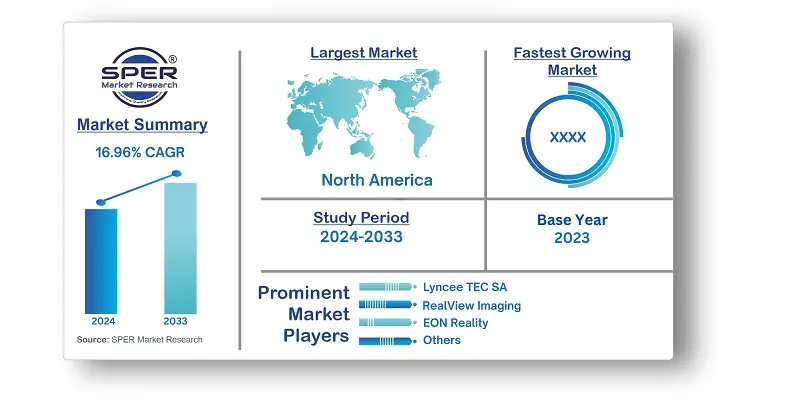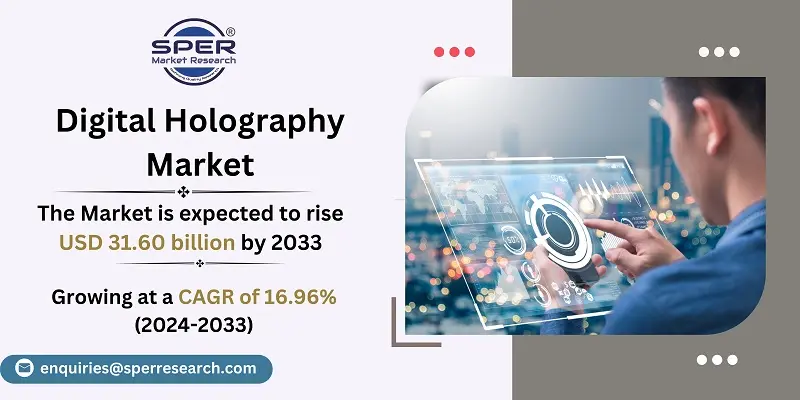
Digital Holography Market Growth, Size, Trends, Demand, Share, Revenue and Future Outlook
Digital Holography Market Size- By Process Type, By Technology Type, By Component Type, By Application, By Vertical- Regional Outlook, Competitive Strategies and Segment Forecast to 2033
| Published: Apr-2024 | Report ID: IACT2481 | Pages: 1 - 223 | Formats*: |
| Category : Information & Communications Technology | |||
- Holoxica unveiled the 5G-to-5G holographic 3D video in November 2021. Holoxica and the Scotland 5G Centre have partnered to present the 5G-to-5G holographic 3D video conversation. Holographic video chats move from lab testing to real-world applications in homes and workplaces thanks to this collaboration.
- To build VR Innovation Academy in Kyoto, Japan, in October 2019, Eon Reality teamed up with SUS Co., Ltd. (Kyoto) and its subsidiary, Cross Reality Co., Ltd. The VR Innovation Academy will provide the necessary skills and knowledge for the Kansai region's augmented and virtual reality solutions.


| Report Metric | Details |
| Market size available for years | 2020-2033 |
| Base year considered | 2023 |
| Forecast period | 2024-2033 |
| Segments covered | By Process Type, By Technology Type, By Component Type, By Application, By Vertical |
| Regions covered | North America, Asia-Pacific, Latin America, Middle East & Africa and Europe |
| Companies Covered | Lyncee TEC SA, RealView Imaging, Phase Holographic Imaging AB (PHI), EON Reality, the company, Holmarc Opto-Mechatronics, Holotech Switzerland AG, Geola Digital UAB, Leia Inc, Ovizio imaging systems, RealFiction, Himax Technologies, Inc, MetroLaser, HYPERVSN, VividQ Ltd, SAMSUNG, Meta. |
- Medical holography companies
- Hospitals and Clinics
- Venture capitalists and investors
- Market research and consulting firms
- Pharmaceutical and biotechnology companies
- Government research institutes
- Research institutes and medical academic institutes
- Medical imaging and diagnostic centers
- Pathological laboratories
| By Process Type: |
|
| By Technology Type: |
|
| By Component Type: |
|
| By Application: |
|
| By Vertical: |
|
- Global Digital Holography Market Size (FY’2024-FY’2033)
- Overview of Global Digital Holography Market
- Segmentation of Global Digital Holography Market By Process Type (Digital Recording, Reconstruction)
- Segmentation of Global Digital Holography Market By Technology Type (Gabor’s Holography, Off-Axis Holography, Others)
- Segmentation of Global Digital Holography Market By Component Type (Hardware, Software)
- Segmentation of Global Digital Holography Market By Application (Digital Holographic Displays, Digital Holographic Microscopy, Holographic Television and Telepresence, Others)
- Segmentation of Global Digital Holography Market By Vertical (Automotive, Medical, Aerospace and Defense, Others)
- Statistical Snap of Global Digital Holography Market
- Expansion Analysis of Global Digital Holography Market
- Problems and Obstacles in Global Digital Holography Market
- Competitive Landscape in the Global Digital Holography Market
- Impact of COVID-19 and Demonetization on Global Digital Holography Market
- Details on Current Investment in Global Digital Holography Market
- Competitive Analysis of Global Digital Holography Market
- Prominent Players in the Global Digital Holography Market
- SWOT Analysis of Global Digital Holography Market
- Global Digital Holography Market Future Outlook and Projections (FY’2024-FY’2033)
- Recommendations from Analyst
1.1. Scope of the report1.2. Market segment analysis
2.1. Research data source2.1.1. Secondary Data2.1.2. Primary Data2.1.3. SPER’s internal database2.1.4. Premium insight from KOL’s2.2. Market size estimation2.2.1. Top-down and Bottom-up approach2.3. Data triangulation
4.1. Driver, Restraint, Opportunity and Challenges analysis4.1.1. Drivers4.1.2. Restraints4.1.3. Opportunities4.1.4. Challenges4.2. COVID-19 Impacts of the Global Digital Holography Market
5.1. SWOT Analysis5.1.1. Strengths5.1.2. Weaknesses5.1.3. Opportunities5.1.4. Threats5.2. PESTEL Analysis5.2.1. Political Landscape5.2.2. Economic Landscape5.2.3. Social Landscape5.2.4. Technological Landscape5.2.5. Environmental Landscape5.2.6. Legal Landscape5.3. PORTER’s Five Forces5.3.1. Bargaining power of suppliers5.3.2. Bargaining power of buyers5.3.3. Threat of Substitute5.3.4. Threat of new entrant5.3.5. Competitive rivalry5.4. Heat Map Analysis
6.1. Global Digital Holography Market Manufacturing Base Distribution, Sales Area, Ingredients6.2. Mergers & Acquisitions, Partnerships, Product Launch, and Collaboration in Global Digital Holography Market
7.1. Global Digital Holography Market Size, Share and Forecast, By Process Type, 2020-20267.2. Global Digital Holography Market Size, Share and Forecast, By Process Type, 2027-20337.3. Digital Recording7.4. Reconstruction
8.1. Global Digital Holography Market Size, Share and Forecast, By Technology Type, 2020-20268.2. Global Digital Holography Market Size, Share and Forecast, By Technology Type, 2027-20338.3. Gabor’s (In-Line) Holography8.4. Off-Axis Holography8.5. Others
9.1. Global Digital Holography Market Size, Share and Forecast, By Component Type, 2020-20269.2. Global Digital Holography Market Size, Share and Forecast, By Component Type, 2027-20339.3. Hardware9.3.1. CCD Camera9.3.2. Laser9.3.3. Micro-display9.3.4. Beam Splitter9.3.5. Mirror9.3.6. Others9.4. Software
10.1. Global Digital Holography Market Size, Share and Forecast, By Application, 2020-202610.2. Global Digital Holography Market Size, Share and Forecast, By Application, 2027-203310.3. Digital Holographic Displays10.4. Digital Holographic Microscopy10.5. Holographic Television and Telepresence10.6. Others
11.1. Global Digital Holography Market Size, Share and Forecast, By Vertical, 2020-202611.2. Global Digital Holography Market Size, Share and Forecast, By Vertical, 2027-203311.3. Automotive11.4. Medical11.5. Aerospace and Defense11.6. Others
12.1. Global Digital Holography Market Size and Market Share
13.1. Global Digital Holography Market Size and Market Share, By Region (2020-2026)13.2. Global Digital Holography Market Size and Market Share, By Region (2027-2033)13.3. Asia-Pacific13.3.1. Australia13.3.2. China13.3.3. India13.3.4. Japan13.3.5. South Korea13.3.6. Rest of Asia-Pacific13.4. Europe13.4.1. France13.4.2. Germany13.4.3. Italy13.4.4. Spain13.4.5. United Kingdom13.4.6. Rest of Europe13.5. Middle East and Africa13.5.1. Kingdom of Saudi Arabia13.5.2. United Arab Emirates13.5.3. Rest of Middle East & Africa13.6. North America13.6.1. Canada13.6.2. Mexico13.6.3. United States13.7. Latin America13.7.1. Argentina13.7.2. Brazil13.7.3. Rest of Latin America
14.1. Lyncee TEC SA14.1.1. Company details14.1.2. Financial outlook14.1.3. Product summary14.1.4. Recent developments14.2. Real View Imaging14.2.1. Company details14.2.2. Financial outlook14.2.3. Product summary14.2.4. Recent developments14.3. Phase Holographic Imaging AB (PHI)14.3.1. Company details14.3.2. Financial outlook14.3.3. Product summary14.3.4. Recent developments14.4. EON Reality, Inc.14.4.1. Company details14.4.2. Financial outlook14.4.3. Product summary14.4.4. Recent developments14.5. Holmarc Opto-Mechatronics14.5.1. Company details14.5.2. Financial outlook14.5.3. Product summary14.5.4. Recent developments14.6. Holotech Switzerland AG14.6.1. Company details14.6.2. Financial outlook14.6.3. Product summary14.6.4. Recent developments14.7. Geola Digital Uab14.7.1. Company details14.7.2. Financial outlook14.7.3. Product summary14.7.4. Recent developments14.8. Leia Inc.14.8.1. Company details14.8.2. Financial outlook14.8.3. Product summary14.8.4. Recent developments14.9. Ovizio imaging systems14.9.1. Company details14.9.2. Financial outlook14.9.3. Product summary14.9.4. Recent developments14.10. RealFiction14.10.1. Company details14.10.2. Financial outlook14.10.3. Product summary14.10.4. Recent developments14.11. Himax Technologies, Inc.14.11.1. Company details14.11.2. Financial outlook14.11.3. Product summary14.11.4. Recent developments14.12. MetroLaser14.12.1. Company details14.12.2. Financial outlook14.12.3. Product summary14.12.4. Recent developments14.13. HYPERVSN14.13.1. Company details14.13.2. Financial outlook14.13.3. Product summary14.13.4. Recent developments14.14. VividQ Ltd14.14.1. Company details14.14.2. Financial outlook14.14.3. Product summary14.14.4. Recent developments14.15. SAMSUNG14.15.1. Company details14.15.2. Financial outlook14.15.3. Product summary14.15.4. Recent developments14.16. Meta419.16.1. Company details14.16.1. Financial outlook14.16.2. Product summary14.16.3. Recent developments14.17. Others
SPER Market Research’s methodology uses great emphasis on primary research to ensure that the market intelligence insights are up to date, reliable and accurate. Primary interviews are done with players involved in each phase of a supply chain to analyze the market forecasting. The secondary research method is used to help you fully understand how the future markets and the spending patterns look likes.
The report is based on in-depth qualitative and quantitative analysis of the Product Market. The quantitative analysis involves the application of various projection and sampling techniques. The qualitative analysis involves primary interviews, surveys, and vendor briefings. The data gathered as a result of these processes are validated through experts opinion. Our research methodology entails an ideal mixture of primary and secondary initiatives.



Frequently Asked Questions About This Report
PLACE AN ORDER
Year End Discount
Sample Report
Pre-Purchase Inquiry
NEED CUSTOMIZATION?
Request CustomizationCALL OR EMAIL US
100% Secure Payment






Related Reports
Our Global Clients
Our data-driven insights have influenced the strategy of 200+ reputed companies across the globe.




















